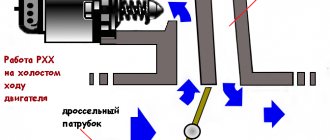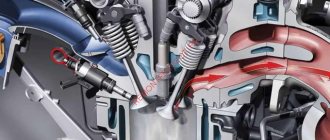08:55 Andrey Ku Home page » Affiliate news
Many drivers who come across the abbreviation VAG do not understand what it means. This abbreviation is the name of the large Volkswagen concern, which, in addition to the automobile plant of the same name, includes several hundred companies producing cars, trucks and off-road vehicles. The name VAG in its full form sounds like Volkswagen Audi Gruppe. It came from two concerns, the merger of which happened before the formation of other brands. In the world there are many fans of cars belonging to this group of car manufacturers, and in Europe the concern occupies a leading position, occupying 25% of the market.
What is VAG?
Often, motorists who have heard about this company do not know what its official name is and what cars it produces. The legal name is Volkswagen Aktiengesellschaft, which translates as “Volkswagen Joint Stock Association”. The designations Volkswagen Konzern and VAG are unofficial but widespread variants that first appeared in print media.
Today there are 342 automobile companies in the community: this will help to understand what VAG is and what the scale of such an enterprise is. According to reports, half of Volkswagen's shares belong to the Porsche group, and the holding itself owns half of Porsche Zwischenholding GmbH. Almost three and a half hundred brands within the concern appeared as a result of the appointment of F. Piekh to the post of chairman of the board, who helped the manufacturer overcome a severe crisis. One of the methods was the purchase of automobile brands, which at that time seemed unpromising and just beginning to fight for competitive positions. All this, coupled with competent management and stricter quality control, allowed us to create the largest concern over the course of a century, supplying cars to countries around the world.
Decoding abbreviations of automotive terms
ALF - alpha (lambda in foreign literature) - excess air coefficient or air / fuel ratio CE - diagnostic lamp (Check Engine) ECU - injection control unit EEPROM - electrically reprogrammable non-volatile memory (chip) EPROM - electrically programmable read-only memory (ROM chip ) FLASH - FLASH memory, a type of ROM GBC - cyclic air flow (cyclic filling) GTC - cyclic fuel supply MAF - mass air flow sensor MAP - absolute pressure sensor RAM - random access memory (chip) RCO - adjustment potentiometer CO ROM - constant storage device (chip)
A/F (air fuel ratio) - composition of the fuel-air mixture air flow meter - air flow sensor air filter (air cleaner) - ATDC air filter - after top dead center. Top dead center is the highest position reached by the piston in the internal combustion engine cylinder. automatic choke - automatic cold start belt - drive belt boost - vacuum value in the intake manifold bore - cylinder diameter BTDS - to top dead center cam - cam choke - air damper ("choke") CAM camshaft - camshaft compression - Common-Rail compression — diesel fuel injection system with a single high-pressure line. A scheme in which constant injection pressure is created by a pump in a common line serving all injectors. The injection timing is determined by the electronic unit that controls the injector valves. FC (FCUT) - FUEL CUT - fuel cut-off FP fuel pump - fuel pump fuel - fuel fan - fan fan motor - fan motor fan belt - fan drive belt fan clutch - fan thermal coupling fan cover - fan casing fast idle - increased (warm-up) speed XX fuel level - fuel level grease - grease gun - grease gun hybrid drive - the car has two different energy sources, for example, an internal combustion engine and an electric motor with a battery. fly wheel - flywheel fuel filter - fuel filter gasket - gasket idle jet - XX jet idle speed - XX speed idler - a shaft that does not drive anything, “sloth” jet - jet IAC (idle air control) - air control in idle mode boost pressure - the pressure at which the supercharger supplies air to the cylinders. The higher the boost pressure, the more oxygen enters the cylinder, the more fuel can be injected, the higher the engine output. The risk of detonation increases IDL (idle) - idle injection - intake inlet manifold - intake manifold intercooler - intercooler (air in turbocharged systems) immobilizer - blocks the engine control, power and ignition systems in case of unauthorized engine start. I/UP - idle up - increasing idle speed injector - injector catalytic converter of exhaust gases - part of the exhaust system. Reduces exhaust gas toxicity. Inside the neutralizer body there is a monolithic ceramic element made of a large number of narrow long honeycomb tubes, coated inside with a special platinum alloy. Instead of a ceramic element, thin metal foil, wound with small gaps between turns, can also be used. LPT - Light Pressure Turbo - low pressure turbocharger LPG (Liquid Petroleum Gas) - a mixture of propane (C3H and butane (C4H10), formed as a by-product at oil refineries. It has a high octane number (over 100), used as fuel for internal combustion engines. lambda probe - sensor for the presence of oxygen in the exhaust gas. Connected with the injection control system. Allows you to ensure a fuel mixture composition that is optimal for the operation of the catalytic converter lifter-pusher MAF (mass air flow) - air volume meter MC (mixture control) - mixture composition control manifold - manifold MPI - multi-point injection, when a separate nozzle is used for each of the cylinders. Unlike central injection, when one nozzle is used, “serving" all cylinders of the engine. MON - Motor Octane Number (?) - octane number according to the motor method Octane the number expresses the detonation resistance of gasoline. Exhaust gas toxicity standards - from January 1, 2000 in Europe, all new model cars must comply with Euro 3 standards, and from January 1, 2001, all new cars coming off the assembly line, the corresponding dates for Euro standards January 4-1, 2005 oil - oil oil filler - oil filler neck oil filter - oil filter oil pan - engine sump OHC (SOHC) - single overhead camshaft - engine design with an overhead camshaft and overhead valves overlap - overlap (of valves) OX SENSOR oxygen sensor - sensor the amount of oxygen in the exhaust gases, the octane number is a conventional indicator of the anti-knock properties of motor fuels. Motor fuel is compared with a mixture of isooctane (taken as 100) and N-heptane (taken as 0). The percentage of isooctane in a mixture that is equivalent in knock resistance to the fuel being tested is called the octane number of the fuel. There are 2 methods for determining 04 - motor and research. piston - piston piston ring - piston ring PCV (positive crancase ventilation) - crankcase ventilation system pipe- tube piston- piston pulley- pulley pump- pump radiator - radiator RON - Research Octane Number (?) - octane number according to the research method RDI FAN ( radiator fan motor) - engine cooling radiator fan motor rish - rich (mixture) seal - spark seal [plug] - spark plug SOHC (singl overhead camshaft) - one camshaft in the block head shaft - stroke shaft - piston stroke TV (throttle body) - throttle body thermostat - thermostat TWIN CAM - double camshaft TGH - exhaust gas temperature THW - temperature heat water - water temperature ("Antifreeze") TURBO - turbocharging. Increases the amount of fresh charge in the engine cylinder by increasing intake pressure. As a rule, supercharging is carried out using a turbocharger that uses the energy of exhaust gases. throttle - throttle The throttle valve in the intake tract regulates in carburetor engines the amount of fuel mixture entering the cylinders, and in engines with fuel injection - the amount of air timing belt - timing chain timing chain - timing chain cetane number - flammability indicator of diesel fuel . To ensure reliable starting and normal operation, modern diesel engines require fuel with a cetane number of about 50. UIS (Unit Injector System) is a pump-injector that injects fuel into the diesel combustion chamber, combining an injector and a single-piston fuel pump. Allows you to achieve high injection pressures. valve - valve valve timing - valve timing valve stem seal, valve seal - valve seal, oil seal VSV (vacum solenoid valve) - solenoid valve on the vacuum line V-belt - V-belt VTEC (Variable Valve Timing and Lift Electronic Control) - electronic control of variable valve phase and lift. Depending on the operating mode of the engine, the system provides drive of the same (for example, intake) valves of each cylinder from one common or two different camshaft cams. wrist pin - piston pin AD - absolute pressure (in the intake pipe) TDC - top dead center HBO - gas cylinder equipment Cylinder head - cylinder head Timing - gas distribution mechanism DBP - absolute pressure sensor DD - knock sensor DF - phase sensor DC - oxygen concentration sensor MAF - mass air flow sensor TPS - throttle position sensor DPKV - crankshaft position sensor DS - vehicle speed sensor DTV - air temperature sensor DTOZH - coolant temperature sensor IM - actuator KV - crankshaft Gearbox - gearbox MZ - module ignition BDC - bottom dead center EG - exhaust gases RAM - random access memory (chip) ROM - read-only memory (chip) SW - software RV - camshaft RDV - additional air regulator IAC - idle speed control SUPB - gasoline vapor recovery system UOZ — ignition timing angle CN — cyclic filling SD — stepper motor ECU — electronic fuel injection control unit ECM — electronic engine management system
Some facts about VAG
Fans of the concern will be interested in learning a number of facts about the company:
- In 2005, enterprises produced a total of 5.22 million units of equipment
- In 2006, the profit of the VAG concern amounted to 2.75 billion euros after deducting all costs.
- Since 2006, the company has been producing a number of Volkswagen models at the Kaluga plant.
- Despite the crisis of 2009, the company managed to increase the rate of car sales by 0.6 (this figure demonstrates how seriously the work with customers is organized and the sales markets are established).
- In 2010, the plant's net profit amounted to 1.55 billion euros.
- The group's head office is located in Wolfsburg.
- VAG automobile manufacturing plants are located in 15 European countries, with a total of 48 such enterprises. In addition, the company owns 6 factories in Africa, the USA and Asia.
- There are also two museums of the concern in Wolfsburg, one of them is dedicated to the history of the cars ever produced by the company, and the second is dedicated to the intricacies of production.
The official website of the VAG group of companies is located at: https://www.volkswagenag.com/
What do the abbreviations AG, GmbH, KGaA mean after the company name?
If in English we are all familiar with company designations, then German designations often look to us simply as a set of large and small letters. What do they mean or what types of companies are hidden on them?In Germany, firms are divided into four classes: small, small, medium and large companies. Depending on the size of the company, there are more stringent requirements for accounting and its official publication (open, please note, it is available to everyone). The classification of a company is determined by three points: balance sheet, profit and number of employees. In all cases, the company’s capital is strictly separated from personal capital, and accordingly, the risks are limited to the available capital within the company.
This separation allows the small business owner to make all the decisions. In particular, who will he hire as the head of the company and how much will he be paid (this is why owners often enter into a contract with themselves to hire themselves and agree on wages with themselves).
Types of companies that can operate in Germany:
Aktiengesellschaft (AG). This is an ordinary joint stock company in its purest form. This is a company whose fund is converted into shares. In turn, all shares of the company are clearly distributed among the owners. It is easy to organize such a company if you have financial resources (the authorized capital must be at least 50,000 € and the first investment must correspond to 1/4 of the authorized capital of 12,500 €) and German citizenship.
Kommanditgesellschaft (KGaA ) is a limited partnership. In order to create it, you need to invest at least 50,000 €. It is worth noting that there is one significant pitfall. If the affairs of the society go badly, then all owners will have to pay not only with their capital, but also with their property. This joint stock company differs from the first type in that it is the owners who always manage their business. Other people invested in the business cannot contribute ideas or influence anything.
Gesellschaft mit beschränkter Haftung (GmbH) is the most popular type of company in Germany. It is akin to a Russian LLC, namely a joint-stock company with limited liability. A GmbH can be founded by one or more persons (as founding partner§ 1 GmbHG) and the shareholders can be both natural and legal persons. The creation amount is €25,000, and at least half must be invested immediately. The remaining amount must be replenished in the following years. It is interesting that you can replenish the authorized capital not only with the help of money, but also by assigning ownership rights to different types of property (real estate, transport, equipment, etc.). You can register an LLC in just a day, but official confirmation and entry of all personal data into the register will have to wait at least another month. The whole process will cost about a thousand euros.
Unternehmergesellschaft . This is a relatively new company for German business and is a subform of GmbH (it is called Mini-GmbH). The authorized capital may be scanty, but 25% of the profits must be invested in the authorized capital until €25,000 is reached and thus the company moves into the upper category of GmbH.
Source: blog about B2B marketing
Common Latin Abbreviations Used in the English Language
It can even be dead, like Latin. For many centuries now there has not been a person in the world who could call Latin his native language, however, many speak it, including you and me.
Latin accompanies us in all areas of life. We have Latin names: Barbara (or the Russian version of Varvara) is a foreigner, Anthony (or Anton) translates as priceless, Victor is a winner, and Chester translates to a fortress. All our months are named after Latin. Latin is the language of ancient philosophers and poets.
Latin was also the international language of communication for European scientists, especially linguists, physicists and biologists. This is why today it is so easy to come across Latin words and abbreviations in documents, instructions, scientific articles, and even in fiction.
Any English-speaking person will understand you if you say am or pm. Just do not overload your interlocutor with additional information that these letters stand for “ante meridian” and “post meridian”. Ps, which stands for “post scriptum” (translated: “after what has already been said”) and CV, that is, “curriculum vitae”, or “life history”, are now as often found in speech as the most common English words. But what can be said about the remaining letters and dots, placed seemingly in a completely random order? Fortunately, the list of Latin abbreviations that are often used in everyday life is not that long.
You've probably come across these 3 abbreviations a thousand times:
- ie = id est = that is
- eg = exempli = for example
- etc. = etcetera = and so on
Others may surprise you:
- a. = annus, anno = year
- a. = Antem = before
- abamic. = ab amico = from a friend (used in correspondence)
- abinit. = ab inito = first
- absque = absque = without
- ac = anni currentis = current year
- acc. = acceptum = received
- acq., acq. = acquisitum, acquisitio = acquired
- a d. = a dato = from date (signature)
- adnot. = adnotavit = mark, mark
- ad fin. = ad finem = to the end
- adint = ad interim = before this
- ad. lib. = ad libitum = at your own discretion
- af = anni futuri = next year
- a mc = a mundo condito = after the creation (of the world)
- ap = anno passato = last year
- bf = bona fide = fair means, good intentions
- c., ca. = circa = approximately
- cf., cfr. = conferatur = compare
- cl = citato loco = in the place mentioned earlier (when quoting)
- cor. cor. impr. = correctis, corrigendis, imprimatur = to correct, correct, print (printing)
- et al. = et alii = and others
- et pass. = et passim = and subsequent, and subsequently
- et seq. = et sequence = and further (used as a reference to the next page, chapter, etc.)
- fec. = fecit = written by so-and-so (used by artists)
- he = hoc est = this means, this means
- ib., ibid. = ibidem = the same, in the same place (used to refer to the source last used)
- ia = inter alia = among other things
- iq = idem quod = in the same way as
- loc. cit. = loco citato = in the quoted place
- LS = locus sigilli = place of printing (printing business)
- NB = Nota Bene = pay attention
- op.cit. = opus citatum = reference to the source that was used last but one (used when it is not possible to use ibid.)
- pa, per an. = per annum = every year, annually
- pro tem. = pro tempore = for some time, temporarily
- QED = quod erat demonstrandum = what was required to be proven
- qs = quantum sufficit = any volume that may be needed
- qv = quod vide = look there
- sl = sine loco = without specifying place
- v., vs. = versus = against
- viz. = videlicet = namely (to provide more complete information on the topic)
- vv = vice versa = in reverse direction
In addition to acronyms, some Latin words and phrases are also commonly used in business and science, such as:
- Ad hoc means that something was specially created or prepared for a specific occasion. Used in a business context and denotes meetings and conferences.
- Verbatim means "literally" and is often used in reports and quotations.
- Modus operandi is used to describe a person's method of working.-
- Sic is a Latin word that translates to “thus” or “thus.”
- De jure means “according to the law” and this concept is often contrasted with the words
- De facto, which means “according to the facts.”
- Ergo means “in this way.” Used to emphasize the speaker's education.
- Vis major means “a higher power” or an act of God that a person or company cannot influence. In Russian, it is often replaced by the French analogue force majeure.
Any classical academic discipline uses its own list of Latin abbreviations: textbooks on law, medicine, botany and biology are half composed of Latinisms.
Latin abbreviations used in history
- au (c.) = anno urbis (conditae) = years since the founding of Rome
- SPQR = Senatus Populus que Romanus = Senate and citizens of Rome (inscription that adorned the standards of Roman legionnaires)
Latin abbreviations used in religious studies
- a. Chr. = ante Christum = BC (before the birth of Christ)
- AD = anno Domini = AD (from the birth of Christ)
- AMDG = ad majorem Dei gloriam = to the greater glory of the Lord
- ap C. = anno post Christum = year after the birth of Christ
Latin abbreviations used in medicine (just a few)
- MDS = Misce. Yes. Signa. = Mix. Give. Flag.
- qs = quantum satis = when necessary, as much as necessary
- Mm. = musculi = muscles
- tid = ter in die = three times a day
Latin abbreviations used in jurisprudence (just a couple)
- corp. del. = corpus delicti = corpus delicti, subject of the crime
- eo = ex officio = from the office, at the place of duty, while on duty
- F. fa., fi. fa. = fieri facias = translated as “fiery face” and denotes a writ of execution
These words, letters and periods are part of the professional jargon of doctors, lawyers, chemists and people in many other specialties. And the above list in no way claims to be complete.
There is, however, one piece of advice that will always be appropriate when you use abbreviations, including Latin ones. When using an unfamiliar set of letters for the first time, explain their meaning in parentheses to make sure the reader understands. After all, this is exactly what we strive for using different methods of communication - to be understood.










